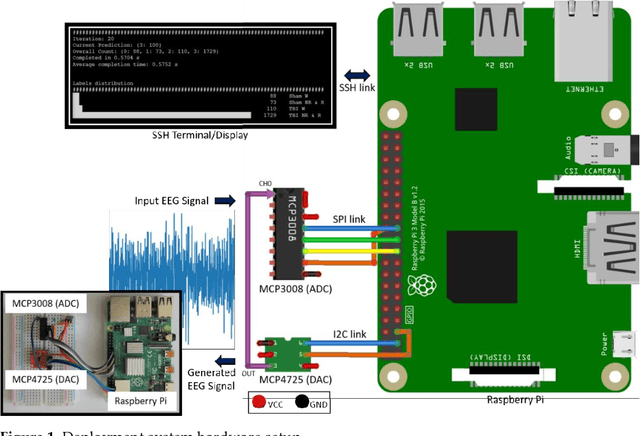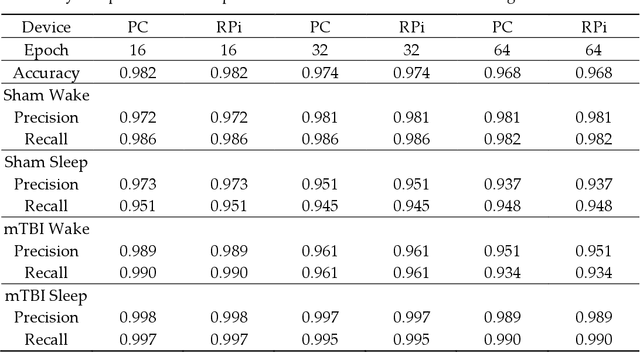Manoj Vishwanath
Reducing Intraspecies and Interspecies Covariate Shift in Traumatic Brain Injury EEG of Humans and Mice Using Transfer Euclidean Alignment
Oct 03, 2023



Abstract:While analytics of sleep electroencephalography (EEG) holds certain advantages over other methods in clinical applications, high variability across subjects poses a significant challenge when it comes to deploying machine learning models for classification tasks in the real world. In such instances, machine learning models that exhibit exceptional performance on a specific dataset may not necessarily demonstrate similar proficiency when applied to a distinct dataset for the same task. The scarcity of high-quality biomedical data further compounds this challenge, making it difficult to evaluate the model's generality comprehensively. In this paper, we introduce Transfer Euclidean Alignment - a transfer learning technique to tackle the problem of the dearth of human biomedical data for training deep learning models. We tested the robustness of this transfer learning technique on various rule-based classical machine learning models as well as the EEGNet-based deep learning model by evaluating on different datasets, including human and mouse data in a binary classification task of detecting individuals with versus without traumatic brain injury (TBI). By demonstrating notable improvements with an average increase of 14.42% for intraspecies datasets and 5.53% for interspecies datasets, our findings underscore the importance of the use of transfer learning to improve the performance of machine learning and deep learning models when using diverse datasets for training.
A Novel ECG Denoising Scheme Using the Ensemble Kalman Filter
Jul 24, 2022



Abstract:Monitoring of electrocardiogram (ECG) provides vital information as well as any cardiovascular anomalies. Recent advances in the technology of wearable electronics have enabled compact devices to acquire personal physiological signals in the home setting; however, signals are usually contaminated with high level noise. Thus, an efficient ECG filtering scheme is a dire need. In this paper, a novel method using Ensemble Kalman Filter (EnKF) is developed for denoising ECG signals. We also intensively explore various filtering algorithms, including Savitzky-Golay (SG) filter, Ensemble Empirical mode decomposition (EEMD), Normalized Least-Mean-Square (NLMS), Recursive least squares (RLS) filter, Total variation denoising (TVD), Wavelet and extended Kalman filter (EKF) for comparison. Data from the MIT-BIH Noise Stress Test database were used. The proposed methodology shows the average signal to noise ratio (SNR) of 10.96, the Percentage Root Difference of 150.45, and the correlation coefficient of 0.959 from the modified MIT-BIH database with added motion artifacts.
A Raspberry Pi-based Traumatic Brain Injury Detection System for Single-Channel Electroencephalogram
Jan 29, 2021



Abstract:Traumatic Brain Injury (TBI) is a common cause of death and disability. However, existing tools for TBI diagnosis are either subjective or require extensive clinical setup and expertise. The increasing affordability and reduction in size of relatively high-performance computing systems combined with promising results from TBI related machine learning research make it possible to create compact and portable systems for early detection of TBI. This work describes a Raspberry Pi based portable, real-time data acquisition, and automated processing system that uses machine learning to efficiently identify TBI and automatically score sleep stages from a single-channel Electroen-cephalogram (EEG) signal. We discuss the design, implementation, and verification of the system that can digitize EEG signal using an Analog to Digital Converter (ADC) and perform real-time signal classification to detect the presence of mild TBI (mTBI). We utilize Convolutional Neural Networks (CNN) and XGBoost based predictive models to evaluate the performance and demonstrate the versatility of the system to operate with multiple types of predictive models. We achieve a peak classification accuracy of more than 90% with a classification time of less than 1 s across 16 s - 64 s epochs for TBI vs control conditions. This work can enable development of systems suitable for field use without requiring specialized medical equipment for early TBI detection applications and TBI research. Further, this work opens avenues to implement connected, real-time TBI related health and wellness monitoring systems.
 Add to Chrome
Add to Chrome Add to Firefox
Add to Firefox Add to Edge
Add to Edge